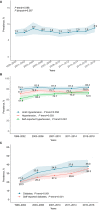Trends and Disparities in Treatment and Control of Atherosclerotic Cardiovascular Disease in US Adults, 1999 to 2018
- PMID: 38639366
- PMCID: PMC11179884
- DOI: 10.1161/JAHA.123.032527
Trends and Disparities in Treatment and Control of Atherosclerotic Cardiovascular Disease in US Adults, 1999 to 2018
Abstract
Background: Although cardiovascular mortality continued declining from 2000 to 2019, the rate of this decrease decelerated. We aimed to assess the trends and disparities in risk factor control and treatment among US adults with atherosclerotic cardiovascular disease to find potential causes of the deceleration.
Methods and results: A total of 55 ,021 participants, aged ≥20 years, from the 1999 to 2018 National Health and Nutrition Examination Survey were included, of which 5717 were with atherosclerotic cardiovascular disease. Risk factor control was defined as hemoglobin A1c <7%, blood pressure <140/90 mm Hg, and non-high-density lipoprotein cholesterol <100 mg/dL. The prevalence of atherosclerotic cardiovascular disease oscillated between 7.3% and 8.9% from 1999 to 2018. A significant increasing trend was observed in the prevalence of diabetes, obesity, heavy alcohol consumption, and self-reported hypertension within the population with atherosclerotic cardiovascular disease (Ptrend≤0.001). Non-high-density lipoprotein cholesterol <100 mg/dL increased from 7.1% in 1999 to 2002 to 15.7% in 2003 to 2006, before plateauing. Blood pressure control (<140/90 mm Hg) increased until 2011 to 2014, but declined to 70.1% in 2015 to 2018 (Ptrend<0.001, Pjoinpoint=0.14). Similarly, the proportion of participants achieving hemoglobin A1c control began to decrease after 2006 (Pjoinpoint=0.05, Ptrend=0.001). The percentage of participants achieving all 3 targets increased significantly from 4.5% to 18.6% across 1999 to 2018 (Ptrend=0.02), but the increasing trend decelerated after 2005 to 2006 (Pjoinpoint<0.001). Striking disparities in risk factor control and medication use persisted between sexes, and between different racial and ethnic populations.
Conclusions: Worsened control of glycemia, blood pressure, obesity, and alcohol consumption, leveled lipid control, and persistent socioeconomic disparities may be contributing factors to the observed deceleration in decreasing cardiovascular mortality trends.
Keywords: cardiovascular disease prevalence; deceleration in mortality decline; health care disparity; risk factor control.
Figures


References
-
- Sawyer A, Flagg LA. State declines in heart disease mortality in the United States, 2000–2019. NCHS Data Brief . 2021:1–8. - PubMed
-
- Murphy SL, Kochanek KD, Xu J, Arias E. Mortality in the United States, 2020. NCHS Data Brief . 2021:1–8. - PubMed
-
- Arnett DK, Blumenthal RS, Albert MA, Buroker AB, Goldberger ZD, Hahn EJ, Himmelfarb CD, Khera A, Lloyd‐Jones D, McEvoy JW, et al. 2019 ACC/AHA guideline on the primary prevention of cardiovascular disease: a report of the American College of Cardiology/American Heart Association task force on clinical practice guidelines. Circulation. 2019;140:e596–e646. doi: 10.1161/CIR.0000000000000678 - DOI - PMC - PubMed
-
- Virani SS, Alonso A, Aparicio HJ, Benjamin EJ, Bittencourt MS, Callaway CW, Carson AP, Chamberlain AM, Cheng S, Delling FN, et al. Heart disease and stroke statistics‐2021 update: a report from the American Heart Association. Circulation. 2021;143:e254–e743. doi: 10.1161/CIR.0000000000000950 - DOI - PubMed
Publication types
MeSH terms
Substances
Grants and funding
LinkOut - more resources
Full Text Sources
Medical

